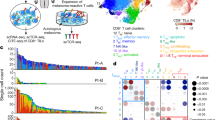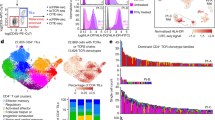Abstract
The cytotoxic activity of T cells selects the outgrowth of tumor cells that escape from immune surveillance by different strategies. The different mechanisms that interfere with immune recognition and limit vaccination efficiency are still poorly understood. We analysed six cell lines established from different metastases of melanoma patient UKRV-Mel-20 for specific characteristics known to have an impact on the tumor-T cell interaction: (1) alterations in the HLA class I phenotype, (2) expression of Fas/CD95, and (3) expression of specific cytokines and chemokines. One of the cell lines, UKRV-Mel-20f, exhibited an HLA class I haplotype loss and just this cell line was also characterised by the expression of Fas/CD95 and of relatively high levels of proinflammatory chemokines suggesting that the cytotoxic activity of tumor-infiltrating T cells might have selected the outgrowth of this tumor cell variant. All other cell lines analysed showed no alterations in HLA class I expression, but, in contrast to UKRV-Mel-20f, expressed much lower levels of Fas/CD95 and of proinflammatory chemokines and some of them produced high levels of immunosuppressive TGF-β1. These results suggest that in patient UKRV-Mel-20, tumor cells interfere with T cell recognition by different strategies which might partially explain why this patient did not have a clinical response to an autologous tumor cell vaccine.




Similar content being viewed by others
References
Barnstable CJ, Bodmer WF, Brown G, Galfre G, Milstein C, Williams AF, Ziegler A (1978) Production of monoclonal antibodies to group A erythrocytes, HLA and other human cell surface antigens-new tools for genetic analysis. Cell 14:9
Bullani RR, Wehrli P, Viard_Leveugle I, Rimoldi D, Cerottini JC, Saurat JH, Tschopp J, French LE (2002) Frequent downregulation of Fas (CD95) expression and function in melanoma. Melanoma Res 12:263
Burrone OR, Kefford RF, Gilmore D, Milstein C (1985) Stimulation of HLA-A,B,C by IFN-alpha. The derivation of Molt 4 variants and the differential expression of HLA-A,B,C subsets. EMBO J 4:2855
Cabrera CM, Jimenez P, Cabrera T, Esparza C, Ruiz-Cabello F, Garrido F (2003) Total loss of MHC class I in colorectal tumors can be explained by two molecular pathways: beta2-microglobulin inactivation in MSI-positive tumors and LMP7/TAP2 downregulation in MSI-negative tumors. Tissue Antigens 61:211
Castriconi R, Cantoni C, Della Chiesa M, Vitale M, Marcenaro E, Conte R, Biassoni R, Bottino C, Moretta L, Moretta A (2003) Transforming growth factor beta 1 inhibits expression of NKp30 and NKG2D receptors: consequences for the NK-mediated killing of dendritic cells. Proc Natl Acad Sci USA 100:4120
Dong H, Strome SE, Salomao DR, Tamura H, Hirano F, Flies DB, Roche PC, Lu J, Zhu G, Tamada K, Lennon VA, Celis E, Chen L (2002) Tumor-associated B7-H1 promotes T-cell apoptosis: a potential mechanism of immune evasion. Nat Med 8:793
Garrido F, Algarra I (2001) MHC antigens and tumor escape from immune surveillance. Adv Cancer Res 83:117
Garrido F, Ruiz-Cabello F, Cabrera T, Perez-Villar JJ, Lopez-Botet M, Duggan-Keen M, Stern PL (1997) Implications for immunosurveillance of altered HLA class I phenotypes in human tumours. Immunol Today 18:89
Hanna J, Wald O, Goldman-Wohl D, Prus D, Markel G, Gazit R, Katz G, Haimov-Kochman R, Fujii N, Yagel S, Peled A, Mandelboim O, Hanna J, Wald O, Goldman-Wohl D, Prus D, Markel G, Gazit R, Katz G, Haimov-Kochman R, Fujii N, Yagel S, Peled A, Mandelboim O (2003) CXCL12 expression by invasive trophoblasts induces the specific migration of CD16-human natural killer cells. Blood 102:1569
Hori S, Takahashi T, Sakaguchi S (2003) Control of autoimmunity by naturally arising regulatory CD4+T cells. Adv Immunol 81:331
Igney FH, Krammer PH (2002) Death and anti-death: tumour resistance to apoptosis. Nat Rev Cancer 2:277
Karre K (2002) NK cells, MHC class I molecules and the missing self. Scand J Immunol 55:221
Khong HT, Restifo NP (2002) Natural selection of tumor variants in the generation of “tumor escape” phenotypes. Nat Immunol 3:999
Lee JC, Lee KM, Kim DW, Heo DS (2004) Elevated TGF-beta1 secretion and down-modulation of NKG2D underlies impaired NK cytotoxicity in cancer patients. J Immunol 172:7335
Lehmann F, Marchand M, Hainaut P, Pouillart P, Sastre X, Ikeda H, Boon T, Coulie PG (1995) Differences in the antigens recognized by cytolytic T cells on two successive metastases of a melanoma patient are consistent with immune selection. Eur J Immunol 25:340
Loetscher P, Uguccioni M, Bordoli L, Baggiolini M, Moser B, Chizzolini C, Dayer JM (1998) CCR5 is characteristic of Th1 lymphocytes. Nature 391:344
Paschen A, Mendez RM, Jimenez P, Sucker A, Ruiz-Cabello F, Song M, Garrido F, Schadendorf D (2003) Complete loss of HLA class I antigen expression on melanoma cells: a result of successive mutational events. Int J Cancer 103:759
Pawelec G, Zeuthen J, Kiessling R (1997) Escape from host-antitumor immunity. Crit Rev Oncog 8:111
Qin S, Rottman JB, Myers P, Kassam N, Weinblatt M, Loetscher M, Koch AE, Moser B, Mackay CR (1998) The chemokine receptors CXCR3 and CCR5 mark subsets of T cells associated with certain inflammatory reactions. J Clin Invest 101:746
Ramal LM, Feenstra M, van der Zwan AW, Collado A, Lopez-Nevot MA, Tilanus M, Garrido F (2000) Criteria to define HLA haplotype loss in human solid tumors. Tissue Antigens 55:443
Real LM, Jimenez P, Kirkin A, Serrano A, Garcia A, Canton J, Zeuthen J, Garrido F, Ruiz-Cabello F (2001) Multiple mechanisms of immune evasion can coexist in melanoma tumor cell lines derived from the same patient. Cancer Immunol Immunother 49:621
Shevach EM, McHugh RS, Piccirillo CA, Thornton AM (2001) Control of T-cell activation by CD4+ CD25+ suppressor T cells. Immunol Rev 182:58
Smalley KS, Brafford PA, Herlyn M (2005) Selective evolutionary pressure from the tissue microenvironment drives tumor progression. Semin Cancer Biol 15:451
Smyth MJ, Trapani JA (2001) Lymphocyte-mediated immunosurveillance of epithelial cancers? Trends Immunol 22:409
Spear BT, Kornbluth J, Strominger JL, Wilson DB (1985) Evidence for a shared HLA-A intralocus determinant defined by monoclonal antibody 131. J Exp Med 162:1802
Sun Y, Jurgovsky K, Moller P, Alijagic S, Dorbic T, Georgieva J, Wittig B, Schadendorf D (1998) Vaccination with IL-12 gene-modified autologous melanoma cells: preclinical results and a first clinical phase I study. Gene Ther 5:481
Tomlinson I, Bodmer W (1999) Selection, the mutation rate and cancer: ensuring that the tail does not wag the dog. Nat Med 5(1):11
Thomas DA, Massague J (2005) TGF beta directly targets cytotoxic T cell functions during tumor evasion of immune surveillance. Cancer Cell 8: 369
von Bernstorff W, Voss M, Freichel S, Schmid A, Vogel I, Jonk C, Henne-Bruns D, Kremer B, Kalthoff H (2001) Systemic and local immunosuppression in pancreatic cancer patients. Clin Cancer Res 7:925
Wang T, Niu G, Kortylewski M, Burdelya L, Shain K, Zhang S, Bhattacharya R, Gabrilovich D, Heller R, Coppola D, Dalton W, Jove R, Pardoll D, Yu H (2004) Regulation of the innate and adaptive immune responses by Stat-3 signaling in tumor cells. Nat Med 10:48
Woo EY, Chu CS, Goletz TJ, Schlienger K, Yeh H, Coukos G, Rubin SC, Kaiser LR, June CH (2001) Regulatory CD4(+)CD25(+) T cells in tumors from patients with early-stage non-small cell lung cancer and late-stage ovarian cancer. Cancer Res 61:4766
Yang L, Carbone DP (2004) Tumor-host immune interactions and dendritic cell dysfunction. Adv Cancer Res 92:13
Zou W (2005) Immunosuppressive networks in the tumour environment and their therapeutic relevance. Nat Rev Cancer 5:263
Acknowledgements
We would like to thank Carmen Amezcua, M. Jose Rivas and Antje Sucker for expert technical assistance. This work was partially supported by the Fondo de Investigaciones Sanitarias, the plan Andaluz de Investigacion, Instituto de Salud Carlos III-Red de Centros de Cancer-RTICCC-contract CO3/10 and the Plan Nacional, Spain as well as the EU 6th framework project ENACT (contract No. 553306).
Author information
Authors and Affiliations
Corresponding author
Additional information
This article is a symposium paper from the conference “Progress in Vaccination against Cancer 2005 (PIVAC 5),” held in Athens, Greece, on 20–21 September 2005.
Rights and permissions
About this article
Cite this article
Méndez, R., Ruiz-Cabello, F., Rodríguez, T. et al. Identification of different tumor escape mechanisms in several metastases from a melanoma patient undergoing immunotherapy. Cancer Immunol Immunother 56, 88–94 (2007). https://doi.org/10.1007/s00262-006-0166-2
Received:
Accepted:
Published:
Issue Date:
DOI: https://doi.org/10.1007/s00262-006-0166-2




